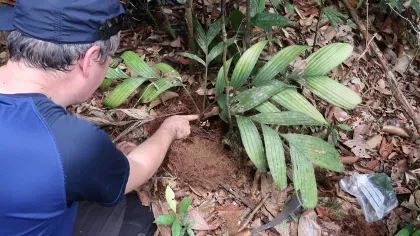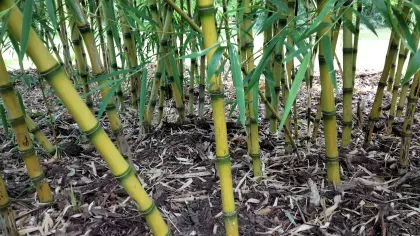13 March 2025
9 min read
Rattan palms and the origins of tropical Asian rainforest diversity
How we combined newly discovered fossils and DNA from global palm collections to understand more about the evolution of one of the most species-rich places on Earth

The tropical Asian island of New Guinea, 1930 meters below ground. An ancient pollen grain, Dicolpopollis, sleeps its deep and undisturbed slumber, snugly covered by billions of tons of rock. Suddenly, the everlasting silence is disturbed by a deep grinding rumble, punctuated by rhythmic clanks and metallic whirs. The sound, distant at first, grows louder and louder and closer and closer. Reverting millions of years of gradual burial in almost an instant, Dicolpopollis is pulled from the depths in a drill core, and sees the light of day again for the first time in more than 90 million years.
When Dicolpopollis lived, dinosaurs still roamed the earth. But the world has changed almost beyond recognition since then, and dinosaurs are no more. Instead, Dicolpopollis now stares into the puzzled eyes of pollen expert Chris Bates, who is trying to figure out what species he has just uncovered, and what its closest modern-day relatives may be.
After consultation with his colleague Robert Morley, he realises with amazement that, unlike the dinosaurs, the relatives of this ancient palm are still thriving: these are the rattans (Calamus and relatives), an iconic tropical Asian palm lineage known both for its fearful spines and its use as the raw material of rattan cane furniture.
The newly unearthed Dicolpopollis is a sensational find: it is more than 20 million years older than any other previously known rattan palm fossils, demonstrating that these palms lived much earlier than previously thought. And as it turns out, New Guinea is still a hotspot for rattan diversity, boasting more than 60 different species of Calamus alone. Dicolpopollis would never have imagined that!


What are the origins of biodiversity?
While Chris is making his fossil pollen discovery, I am in Borneo, collecting my first rattan palms under the dense and multi-layered canopy of Lambir Hills National Park, which boasts one of the most species-rich rainforests on earth.
Here, in less than a square kilometre, more than a thousand tree species can be found. Comparing this to the only roughly 500 tree species that can be found across all of Europe, I am taken aback by the astonishing diversity of the Bornean rainforests.
I wonder, where did all this diversity come from?

Like me, many generations of biologists have spent their days pondering this question, and have usually arrived at the conclusion that it must somehow be linked to the vast and island-dominated landscape of the Asian tropics: they span a distance of over 8,000 km that ranges from India to Australia and comprise more than 20,000 islands, including the two largest tropical islands on earth: Borneo and New Guinea.
However, researchers are still struggling to explain when, where and how this breathtaking diversity has come into existence.

How do islands create biodiversity?
There are only two ways in which any region, such as New Guinea, can build up its community of species.
- Immigration, where species arrive from other regions, such as neighbouring islands or continents, through dispersal.
- The formation of new species from existing species, known as speciation, within the region itself.
To understand the origins of tropical Asian biodiversity through time and space, I require the ability to accurately estimate dispersal between and speciation within its many different regions and islands.
This may sound simple enough, yet the relative importance of dispersal and speciation in generating the tropical Asian diversity of plants, fungi and animals is unknown, even for the largest islands. The reason for this lack of understanding is a lack of data: estimating dispersal and speciation requires detailed information on the evolution of plant and animal lineages that are species-rich throughout the Asian tropics, yet such data remain scarce.
But with the recent advent of new DNA sequencing technologies, I believe that we should finally be able to address this knowledge gap by leveraging the world’s herbarium collections of dried plants, including the fantastic palm collections at Kew.

Creative solutions for building a rattan tree of life
Soon, I have assembled an international team of fourteen experts specialising in the taxonomy, palaeontology and evolution of palms.
Our efforts to study the evolution of rattans are helped by a collaboration with the company IKEA of Sweden AB. This collaboration has the very practical aim of developing DNA-based authentication of rattan cane furniture for a more sustainable rattan cane industry. Through this collaboration, we have the funds to sequence hundreds of genes of all rattan palms, which in turn will allow us to not only identify furniture made from rattan palms, but also to gain insights into their evolution.
With all of the new DNA information gained from our herbarium specimens and sustainability collaboration, I generate a new tree-of-life that reflects the evolutionary relationships between almost all rattan palms.
I combine this tree-of-life with fossil data, including the ancient Dicolpopollis pollen fossils from New Guinea, to generate estimates when modern rattan palms and their ancestors came into existence. Finally, I add data about the locations in which modern rattan palms are found to the mix, allowing me to infer where the rattans originated, how they spread across the Asian tropics, and by which means they diversified into the around 500 currently recognised species.

Revealing island contributions to tropical Asian biodiversity
Based on these analyses, I am able to show to what scale rattan palms have dispersed between regions and how much they have speciated within regions.
From this, I can shed new light on the origins of the astounding biodiversity of the Asian tropics. By devising a new way to classify the different regions based on their role in the emergence of new species and the dispersal of others to new regions, I can explain the assembly of species in individual tropical Asian regions, and how they each contributed to the overall rattan diversity.
My analyses reveal Borneo as the only radiator, a region that both generates high new species diversity and distributes it to other regions. Borneo, situated in the centre of the Asian tropics, is also the one and only gateway between regions to its west and east, highlighting it as the most important region of the Asian tropics in establishing their modern-day rattan diversity.
Corridors such as Sumatra play an important role in connecting neighbouring regions, whilst accumulators such as India mainly acquired diversity generated elsewhere.
And what about New Guinea? Notwithstanding the 90-million-year-old Dicolpopollis fossils from New Guinea, our analyses suggest that that the rich rattan flora of New Guinea was generated in relative isolation from very few colonisation events, revealing the island as an incubator. Fascinatingly, these colonisation events happened less than 25 million years ago. This suggests that New Guinea’s rattan palms are not, as you may have expected, the direct descendants of these ancient palms, but rather that the rattan flora of New Guinea went extinct at some point and was much later re-colonised to form its modern rattan flora.


Implications for the conservation of biodiversity
With a still rapidly growing human population, and rapidly shrinking tropical rainforests, this new understanding of regional roles in generating the overall diversity of the Asian tropics has potential implications for conservation.
With limited resources, we cannot protect the entire Asian tropics but may need to focus our efforts on individual regions. I believe that our regional classification may provide valuable information in deciding where our conservation priorities truly are.
Finally, I wonder whether the lessons learnt from rattan palms may also apply to other plant or animal lineages. Rattans are dispersed by a broad range of animals, such as birds, mammals or even lizards. The biogeographic patterns of rattans thus reflect the dispersal abilities of these animals, and also of other animal-dispersed plants.
The dispersal and speciation of rattan palms are also closely related to the geographical characteristics of tropical Asian regions, such as geographical isolation or area. The high number of species generated in isolation in New Guinea, for example, can be explained by the large area of the island and its isolation from other landmasses. It is therefore likely that the same biogeographical principles will apply to other forms of life, which should result in similar patterns of dispersal and speciation.

More studies of other plant, fungal and animal groups are needed
By studying the evolution of rattan palms, we were able to gain substantial new insights into the origins of tropical Asian biodiversity. I hope that this is only the beginning, and that many more studies of other model lineages will follow.
If scaling up the approach taken for rattan palms to other lineages that account for the many many different aspects of biodiversity, such as plants, fungi and animals, different habitats, dispersal modes, and lineage ages, we may be able to gain a truly comprehensive understanding of the origins of the breath-taking tropical Asian biodiversity and piece together part of the great puzzle on how the diversity of life on earth came into existence.
Access the scientific resources behind this story

Read the full publication in Science
Island geography drives evolution of rattan palms in tropical Asian rainforests

Or check out our commentary piece attached to this research
Reading palms to characterize islands
Plant material was provided by Royal Botanic Gardens Kew (UK), New York Botanical Garden (US), Naturalis (Netherlands), J. T. Adorador (University of the Philippines at Los Baños), Herbarium Universitatis Florentinae (Italy), Herbarium Bogoriense (Indonesia), L.H. Bailey Hortorium Herbarium (US), Forest Research Institute Malaysia (Malaysia), Missouri Botanical Garden(US), Singapore Herbarium, Australian National Herbarium, Papua New Guinea National Herbarium, Herbier National (France), Sarawak Herbarium (Malaysia), United States National Herbarium(US), Herbarium of the Arnold Arboretum (US), Herbarium of Aarhus University (Denmark), Bangkok Herbarium (Thailand), Natural History Museum (UK), Fairchild Tropical Botanic Garden(US), Conservatoire et Jardin botaniques de la Ville de Genève(Switzerland), Swedish Museum of Natural History and Á. Cano(University of Cambridge). The Sarawak Forestry Corporation facilitated field work in Borneo [permits (207)JHS/NCCD/600-7/2/107 and WL107/2018]. L. Csiba, R. Cowan, P. Malakasi, and D. Devey provided technical support. A. Antonelli, T. Utteridge, B. Lopez, and five anonymous reviewers gave feedback on the manuscript. Santos Ltd. and the previous operator, Oil Search Ltd., provided permission to publish the descriptions and locations of the fossils described here. Computational analyses were conducted using facilities of the Royal Botanic Gardens Kew and The James Hutton Institute and NIAB (“UK’s Crop Diversity Bioinformatics HPC,” BBSRC grant BB/S019669/1).
This work was supported by Natural Environment Research Council grant NE/L002612/1 (B. Kuhnhäuser); a Clarendon Scholarship by the Clarendon Fund and Brasenose College (B. Kuhnhäuser); an Emily Holmes Memorial Scholarship by the Amar-Franses & Foster-Jenkins Trust (B. Kuhnhäuser); the Garfield Weston Foundation under the Global Tree Seed Bank (S. Bellot); NERC Independent Research Fellowship grant NE/S014470/1 (G. Chomicki); UKRI Frontier Research grant EP/X026868/1 (G. Chomicki); VILLUM FONDEN research grant 00025354 (W. Eiserhardt); Bentham-Moxon Trust grant BMT1-2017 (B. Kuhnhäuser, W. Baker); Bentham-Moxon Trust grant BMT36-2018 (B. Kuhnhäuser, W. Baker); IKEA of Sweden AB (W. Baker); a National University of Singapore startup grant (J. Lim); and the Calleva Foundation (W. Baker).
.jpg.webp?itok=RA0lRJdD)


